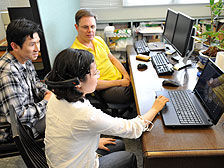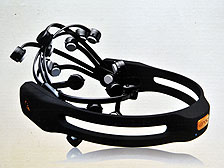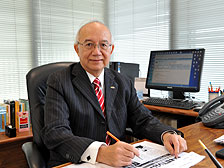
Triple test:
The project team says the main challenge has been to make the brain-computer interface easy to use, fast and accurate.

Economical solution:
The brain-computer interface requires a portable encephalograph headset that costs about $6,000. Comparable medical systems can cost up to $500,000.

Homegrown innovation:
Government Chief Information Officer Daniel Lai is optimistic about the project’s prospects.
Opening lines of communication
April 29, 2012
Most of us take the ability to communicate freely for granted. When robbed of this ability through accident or illness, a person feels devastatingly isolated. To help severely paralysed people to reconnect with friends and loved ones, the Chinese University of Hong Kong has developed a system to allow them to share their thoughts.
The system uses a brain-computer interface that allows literate Chinese users to ‘type’ Chinese characters using their brainwave activity.
Research Associate James William Minett, who heads up the project team, said it targets severely paralysed people who can no longer communicate through speaking, writing or signing. These include people with neuromuscular disease, stroke victims, and those suffering from “locked-in syndrome”, in which they are nearly completely paralysed but are fully conscious.
The brain-computer interface is a portable encephalograph, a device with electrodes that attach to a person’s head to measure and record electrical activity in the brain, that is also connected to a computer.
Individual Chinese characters are written in strokes in a particular order. To begin communicating, the user chooses one of five different strokes presented on the computer screen one by one. When the one the user wants flashes onscreen, it will trigger a particular brainwave, detected by the encephalograph.
Educated guesses
The user would then choose the next stroke, and the next. The software uses predictive text technology, so the system can “guess” which character the user wants within a short number of selected strokes.
"If you are writing something like Causeway Bay, that’s a lot of strokes you have to input. Instead of requiring the users to input all of them, we start predicting which are the most likely characters to match the stroke. We feel that is quite an easy way to start," he said.
It can take from three to five minutes for the unit to process even a short, simple sentence, from the receipt of brainwaves, to system identification and translation.
"If the system we have developed can allow someone to communicate - even if only a single Chinese character each minute - I believe their quality of life can be improved, and our time has been put to good use," Mr Minett said .
Honing accuracy
The project consists primarily of developing and refining the software, he said. The main challenge has been making it easy to use, fast and accurate. Factors beyond the developer’s control can sometimes affect its performance.
"People have different moods, different mental states, different levels of tiredness, and might use the system in different environments, so of course performance would be affected by that,” he said.
The team is tweaking the system, to adjust its performance to suit each individual’s needs.
"I think it can really change their lifestyle for the better, so I think we are working towards something very useful," he said.
Free download
This project is among nine projects sponsored by the Office of the Government Chief Information Officer’s Development of Assistive Technology for Persons with Disabilities Fund.
It granted about $190,000 for the system’s development. Government Chief Information Officer Daniel Lai is optimistic about the project’s prospects.
“This particular solution, which uses brain waves and translates them into Chinese characters, is very important. There has been some development for the production of such words in English. But this is the first one to use brainwaves to translate into traditional Chinese characters.”
The software interface will be available for free download within a month. Users require a portable electroencephalograph headset that costs about $6,000. Comparable medical systems can cost from $200,000 to $500,000, so the low-cost gives this system a definite advantage.
An exhibition to be held from May 11 to 14 at Central Library will showcase all nine projects, and encourage the development of more such assistive tools and applications for people with disabilities.